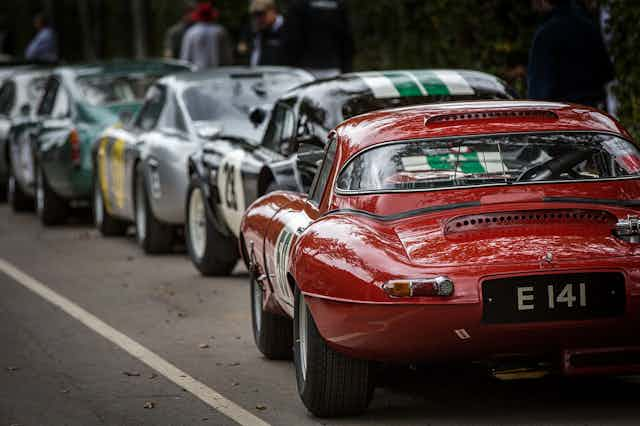Britain excels at heritage-as-spectacle affairs, and they rarely get better than the Goodwood Revival. The latest instalment of this classic motoring festival kicks off on Friday September 9, at a historic racing track in the heart of the Sussex countryside. Since its launch in 1998, it has become phenomenally successful. More than 100,000 visitors come through the gates over three days, the majority in meticulously curated vintage outfits. But the real magic is the dedication, skills and labour which underpin the nostalgia by getting the cars to the track in the first place.
Goodwood might be the best event of its type in the world. Only vehicles that would have been eligible to race on the original circuit from 1948 to 1966 are allowed to do so now, and all other vehicles on the grounds have to be of the same period. Rare and beautiful beasts and gems arrive in “concours condition” while thousands more are found in the visitors’ parking.
Beyond Goodwood, there are more than 850,000 “classic cars” being kept from the scrap heap in the UK. That is thanks in part to the financial commitment and dogged devotion of owners, but in reality, the show can only go on thanks to the largely invisible labour of mechanical specialists, panel beaters, painters, welders, coachwork specialists, trimmers and other craftspeople who nurture and heal the classics’ many aching joints.
Behind every barn-find-to-auction star and heirloom car is the story of those who repair, restore and maintain these machines laden with tales and memories.

Generation gap
You can meet some of the specialist engineers behind the celebrated racing cars in the Goodwood Revival paddocks (special passes are required for this inner sanctum). However, the vast majority of classic car workers are toiling away across the country in small workshops and garages, often self-employed. Many are getting on a bit, becoming that grey-haired craftsman who knows how to fix things they don’t make anymore.
And so the Federation of Historic Vehicle Clubs says we have a “ticking time bomb”: an imminent shortage of specialist skills for the classic cars we seem to love more and more. Practical Classics, a leading sector magazine with a firm hold on the grassroots’ pulse, found in a recent survey that craftsmen with traditional skills are retiring faster than they can be replaced. Attempts to bring more young people into suitable training having “only limited, localized success”.
This is not just bad news for classic car obsessives, but offers another angle on the well-known British demand-and-supply skills mismatch. The Historic Vehicle Research Institute estimated in 2011 that classic motoring as a sector generates over £4 billion and more than 28,000 people earn all or some of their living from it.

Given the rise of a broader “vintage economy”, even the more humble classic family car can be worth something if some time and money is put into it. Check any local paper and there will likely be a classic car event near you, not to mention a full calendar of massive national events like the annual shows at Birmingham’s NEC. Sector media is rich, varied and globally acclaimed, auction houses and dealerships have done well out of the boom. Despite a recent “cooling off”, the sector has grown rapidly in recent years. The trouble is that the skills base is contracting.
Diversion
Classic car hobbyists have traditionally been amateur restorers or at least repairers. For many, much of the fun in classic car ownership is in the “tinkering” with a project car. As modern cars have become more dependent on electronics, first-hand experience of getting hands dirty fixing things has steeply declined. As a new generation becomes interested in classic cars, they are also less able than ever to do the work themselves. That should further increase the demand for a skilled workforce.
So far, most of the lobbying and publicity has focused on apprenticeships, with the oft-repeated assertion that 1,000 are needed to replenish the sector. Several colleges including Banbury and Bicester, City of Oxford, Reading and central Nottingham – near concentrations of car and classic car specialists – have launched schemes in recent years. Trainees are typically at a college 1-2 days a week and spend 3-4 days at the workplace, leading to Level three qualifications in around 36 months.
This sounds great on paper, but numbers are nowhere near what is desired despite good retention rates and decent buy-in from employers. One issue might be age: current funding schemes basically demand that over-25s pay their own way. This curtails their recruitment into a field most become aware of and drawn to slightly later in life.

This aligns with what is witnessed at the renowned full-time classic car restoration college course at Leeds City College, one of a handful in the country. Cohorts of 10 to 15 routinely comprise of trainees with highly varied career experiences behind them, many in their late 20s and early 30s. It is a big financial sacrifice and the decision to pursue something they love often follows from substantial soul-searching. If the accessibility to a broader age-range of trainees could be married with the practical experience provided by the apprenticeships schemes, it would be very good news for the future of historic motoring in the UK.
The Goodwood Revival roars on with all the self-assuredness of James Bond’s Aston Martin on a winding country road on a fine day. But it was always Q who kept Bond moving, and to make sure the ride is smooth and long into the future, Britain would be wise to make sure there are plenty more Qs in the making.

